Find the original Spanish-language article here.
The present analysis swims against the widespread morbid thinking and well established opinion, namely that China will undoubtedly end up invading Taiwan by force and that it will manage to do so without any kind of impediment, let alone resistance, fast and furiously defeating both the Taiwanese and the Americans or whoever else daring to approach the Strait of Taiwan that new D-Day. No one in his right mind can question this dogma, even if he is right and can prove it. Consequently, I am not in my right mind, I do question the dogma and I am going to prove that I am damned right.
Taiwan is not Ukraine (in case you didn’t notice)
Despite not being an issue disregarded by the mass media, Russia’s invasion of Ukraine has brought back to the news an upcoming —imminent, we are assured without embarrassment— Chinese military invasion of Taiwan. Analysts believe that China is closely monitoring how the US responds to Putin’s challenge in Ukraine and that will take careful note of Washington’s and NATO’s reaction against Russia.
To be honest, they are not completely wrong, but they do are mistaken in thinking that the war in Ukraine will determine whether or not Peking (yes, I like classic toponymy) decides to launch a full-scale amphibious invasion of Taiwan. The reason is that, despite all appearances, China still lacks the required military capability to do so in the short and medium term.
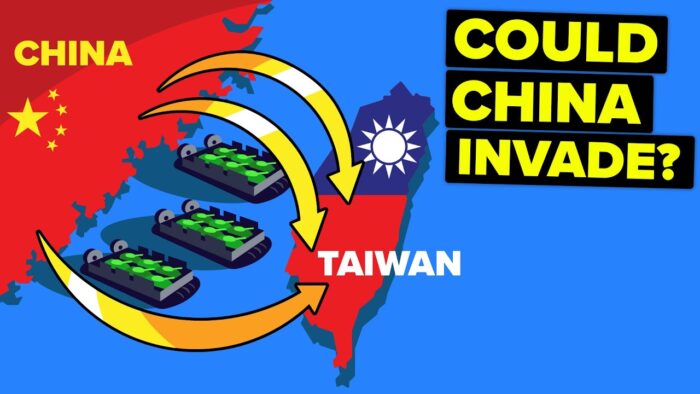
Can China successfully invade and subdue Taiwan island? Our analysis rejects this possibility.
Two completely different military operations (again, in case you didn’t notice)
Firstly, it should be pointed out that although China could carpet bomb Taiwan with ballistic and cruise missiles and employ hybrid warfare tactics to weaken the island before setting a foot on it, the heavily armed Taiwanese military is not the Ukrainian army and, secondly, Taiwan and China do not share a land border like Russia and Ukraine, but rather a strip of sea, the Strait of Taiwan, which would be immediately mined by Taiwan as soon as war begins.
Therefore, as powerful as China is —an alleged fact that nobody dares to question except me—, if it intends to occupy the island it can only be done by carrying out a large-scale amphibious landing (far larger than the Normandy landing), which means a completely different military operation than the one the Russian army ―or Putin, according to media’s narrative― develops on Ukrainian territory.
However, Western’s obsession about a war breaking out between the two shores of the Taiwan Strait has been fueled since many years by the United States Indo-Pacific Command, which warns us about the gradual formation of the required forces by China to invade and subdue Taiwan, pointing out that it could be as soon as 2030.
Meeting such a tight deadline could sound pretty difficult at first glance, but it is not impossible in light of China’s unwavering determination to (re)unify Taiwan with the mainland and realize the long-awaited dream of ‘One China’ (oh yes, there are two, sorry). Still, such analysis is based on a fundamental misperception about the ability of Chinese Navy (PLAN) to launch a large-scale amphibious attack.
If China were to launch such an operation against Taiwan, the following questions should be asked: what would China need in terms of fighting forces and force levels? Does it have the numerical superiority and the necessary military and logistical capabilities? If not, when could China have already organized those forces, which would add up to hundreds of thousands of troops and thousands of ships and landing crafts?
To date no one has successfully addressed the study of these issues. Existing studies have focused on how (by sea, yes, we already know that), but not on the specific requirements in terms of both human and material resources required for the invasion.
Military background against Peking (letting you know it)
As a matter of fact, there are two examples of failed invasion attempts on territory under control of the Republic of China (ROC), rather than Taiwan island itself. In 1949, just after the civil war on continental soil between Mao Zedong’s communists and Generalissimo Chiang Kai-shek’s nationalist side, the by then undefeated People’s Liberation Army (PLA) launched its first amphibious assault in its short history to take the small archipelago of Kinmen (Quemoy), just 2 km away from Xiamen (Amoy), the latter already in the hands of the communists.
The Battle of Kinmen/Quemoy, known in Taiwan as the Battle of Guningtou Beach, took place from October 25th to the 27th, 1949, just a few weeks after Chairman Mao proclaimed the founding of the People’s Republic of China (PRC) from the balcony at the Forbidden City in front of Tiananmen Square.
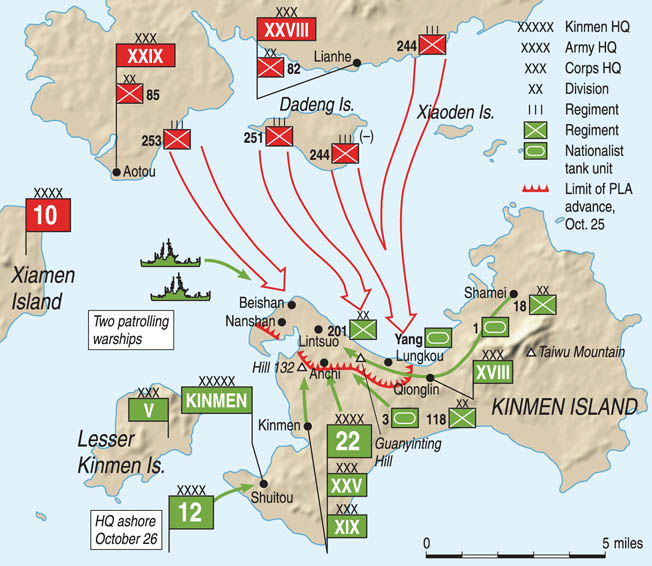
The unsuccessful amphibious landing on Kinmen/Quemoy Island.
The operation ended in complete disaster for the red hordes. Of the 20,000 troops deployed during the assault, only 9,000 managed to land aboard 200 boats previously confiscated to the nationalist army. The result was the humiliating defeat of three PLA regiments at the hands of a nationalist contingent that, it should be noted, had withdrawn to that tiny archipelago after suffering successive defeats on mainland. The failure at the Battle of Kinmen was a serious blow to PLA’s morale since it uncovered its inability to carry out an amphibious landing.
The second landing, also unsuccessful, took place in the Battle of Dengbu Island, in the Zhoushan (Chusan) archipelago in front of Ningbo. The attack ran from the 3rd-5th of November, 1949, and resulted in another ROC’s victory. Again, some 20,000 attackers succumbed to an unknown number of KMT defenders who inflicted a loss of 3,600 men to PLA forces, almost the same number as in the Battle of Kinmen (3,800). However, nationalist troops were later forced to withdraw when the PLA gained air superiority over the archipelago, ultimately leaving Dengbu Island under PRC’s control.
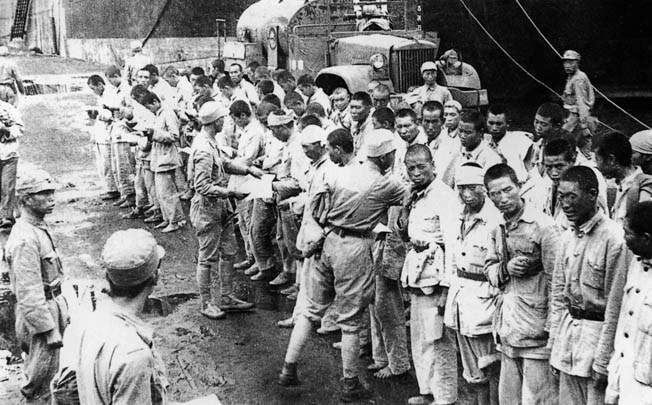
In Kinmen, 5,175 PLA soldiers were made POW by KMT forces.
Successful invasions of Taiwan (none of them by commies)
Believed or not, Taiwan has been successfully invaded through amphibious landing by two different Chinese armies from the mainland, the USA, France and even by Japan in two occasions (oh yeah baby, spare it to the commies). Red China failures could have made a case for the impregnability of Taiwan, but the truth is that not everybody is an invincible superpower as the PRC… Therefore we can guess why Taiwan hasn’t been subdued by China yet, surely because the challenge ain’t big enough.
We also can imagine that Nancy Pelosi’s recent visit to Taiwan was made through holographic manipulation on TV, otherwise we are incapable of figuring out how her plane landed on Chinese territory (they say Taiwan belongs to them). Joking aside, Pelosi’s visit shows that in Taiwan anyone can spend a night without being disturbed. Her visit could even serve as slogan for encouraging tourism to the island: ‘Visit Taiwan, it’s safe!’, ‘She did it, what are you waiting for?’ And as far as we are concerned, it is safe and you shouldn’t wait for anything. Just remember to put on the earplugs to avoid hearing the barking of the Pekingese dog, but don’t worry because there is no real danger of being bitten. It has been proven by Pelosi.
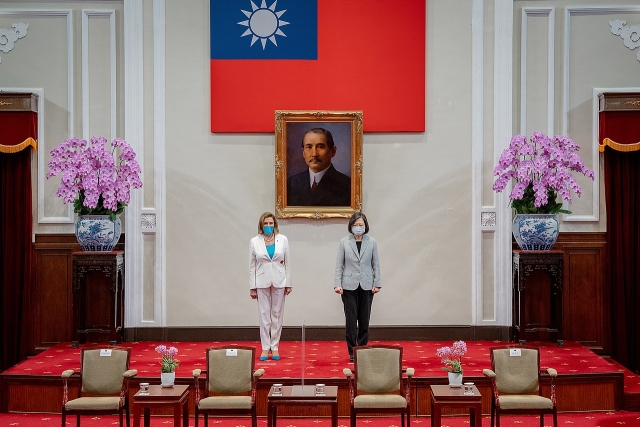
Nancy Pelosi received by the democratically elected President of the Republic of China, Tsai Ing-wen, at the presidential palace in Taipei. Behind them, the portrait of Sun Yat-sen, founder of the Republic.
Coming back, after this digression, to the successful invasions of Taiwan, if we do not take into account the Spanish and Dutch invasions, which were more a process of colonization (very short in the Spanish case) than the product of military invasions by means of a sole amphibious landing, then we are left with six successful invasions and their respective heroes or villains —Coxinga, Shi Lang, the Americans, the French and the Japanese Empire (needless to say who are the villains, right?). Anyway, believed or not, liked or not, the PRC is not on the list…
Taiwan had never been formally incorporated into China by any of the pre-Manchu dynasties. Furthermore, the glorious Ming dynasty (1368-1644), immediately prior to the Qing dynasty (1644-1912), had even indirectly but clearly acknowledged that it did not consider Taiwan part of its territory in a letter to a Dutch captain who requested permission to land on the Pescadores Islands, just in front of Taiwan. Ming government warned the Dutch captain not to set foot in the Pescadores, as it was under their sovereignty, but instead told him that they could sail to Taiwan and set foot in it.
In 1661, General Koxinga, a corsair of Japanese blood faithful until his death to the Ming dynasty against the Manchu invader, launched from the island of Quemoy, today still under the sovereignty of the Republic of China, a successful amphibious assault on Taiwan to set it free from the occupation of “the red-haired barbarians”, meaning the Dutch invaders. After Dutchmen surrender, General Koxinga proclaimed de Kingdom of Tungning, an hereditary monarchy which lasted until 1683.
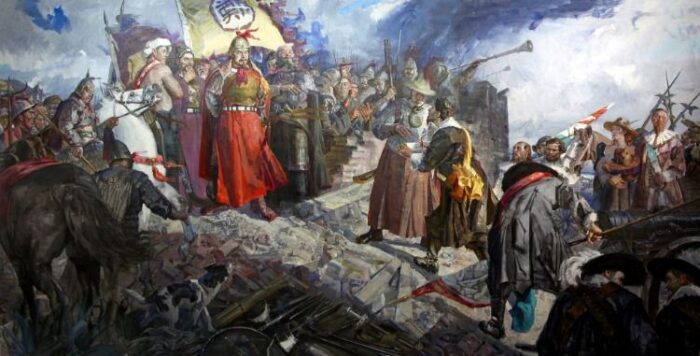
General Koxinga accepting the surrender of the Dutch in Fort Zeelandia, south of Taiwan near today’s Tainan city.
After the Dutch were expelled from Taiwan by General Koxinga, Admiral Shi Lang, called in China the ‘Liberator of Taiwan’, a naval officer under Koxinga’s orders before swearing allegiance to the new Qing dynasty —fleeing from which Koxinga had moved to Taiwan due to his loyalty to Ming dynasty—, also undertook a successful amphibious landing in 1683 to incorporate Taiwan to the jurisdiction and sovereignty of the Manchu dynasty, the last to rule China.
In that operation, Admiral Shi Lang mobilized some 300 junks and 20,000 troops, invading first the Pescadores Islands and from there the whole Taiwan island, ultimately overthrowing the hereditary dynasty started by Koxinga when he established the kingdom of Tungning after expelling the Dutch in 1661. Curiously, but not surprising since he conquered Taiwan, Shi Lang was the unofficial name circulating on the Internet for many years to name the unfinished hull that would later become the Liaoning CV-16, the first Chinese aircraft carrier.
When Shi Lang conquered Taiwan in 1683 and handed it over to its new masters, the Manchus of the Qing dynasty, that was the first time Taiwan came under the official rule of a Chinese dynasty. It is true that during the reign of the Koxinga clan, the island was ruled by the Han ethnic group for the first time in its history, but because the Ming dynasty had already been defeated and replaced by the Manchus on the mainland, the kingdom of Tungning cannot be considered as the legal and legitimate government of Ming in Taiwan, since the proclamation of the kingdom took place when that dynasty had already cesed to exist.
Comparing those two invasions with the current situation, the role that communist China and Taiwan play in the crisis of the Taiwan Strait is very similar to that of the Qing dynasty and General Koxinga’s Kingdom of Tungning. Today in Taiwan continues to exist the same nationalist state —the Republic of China proclaimed in 1912— that ruled the Mainland before moving to the island, just as the Kingdom of Tungning was founded after the withdrawal to Taiwan of nationalist Ming soldiers and civilians to avoid being ruled by the Manchus.
As for the People’s Republic of China, it matches the role played by the Qing dynasty after defeating the Ming on the Mainland, with the launching of an attack to conquer Taiwan, something that Red China still has to do (keep calm, it won’t happen). Please note, however, that for both the Manchus and the Communists of the PRC, the taking of Taiwan was not, would not and will never be a reconquest, but a conquest, since Taiwan was never and has never been under the ruling of those two States at the time of their foundation.
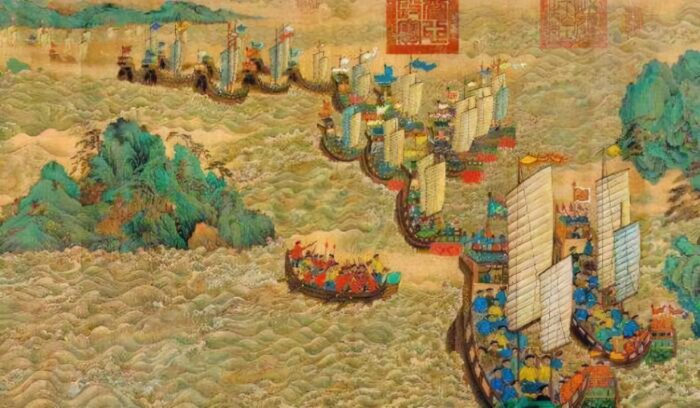
Depiction of Admiral Shi Lang’s fleet heading for Taiwan via the Pescadores Islands.
The 19th century witnessed a string of foreign countries militarily landing in Taiwan. The first one was the United States of America, which just by this can already take more credit than the almighty PRC. The Formosa Expedition or the Taiwan Expedition of 1867 are the historical names of that operation. A punitive expedition launched by the US against the Paiwan, an indigenous Taiwanese tribe.
The expedition was undertaken in retaliation for the Rover Incident, in which an American ship of that name was wrecked in Taiwan’s shore and its survivors (including a woman) got massacred by Paiwan warriors in 1867. A company of Marines carried by a US Navy ship made its landing in southern Taiwan and advanced into the Paiwan village. However, the Paiwans responded with guerrilla warfare, repeatedly ambushing, skirmishing, disengaging and retreating from the enemy.
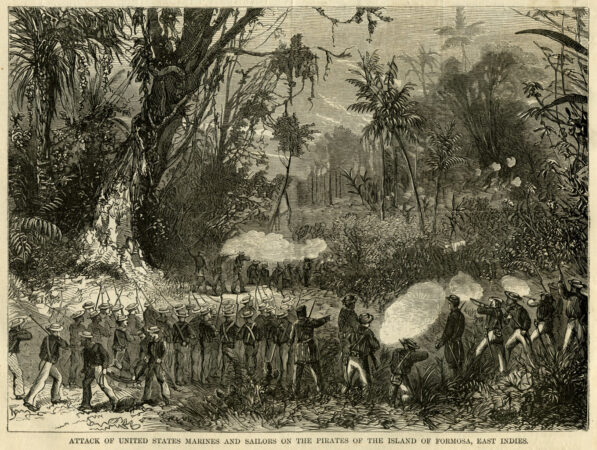
Depiction of a battle between Marines and indigenous Paiwan warriors, published by the American newspaper Harper’s Weekly in 1867.
Eventually, the Marines’ commander was killed and the American troops retreated to their ship due to fatigue and heat exhaustion, while the Paiwan dispersed and retreated into the jungle. Although the Formosa Expedition is regarded as an American failure, the amphibious landing was successful and that is the reason why we have included it on this list. Yes, the one which the PRC is totally absent from.
The fourth successful invasion of Taiwan was carried out by the Japanese Empire (oh, that evil entity for the commies) in 1874, although the Japanese invaded again in 1895. Their first landing and invasion of the island is known as the Japanese Punitive Expedition to Taiwan or Taiwan Expedition. It was a brief retaliatory operation to avenge the murder (beheading) of 54 Ryukyuan sailors by Paiwan tribe aboriginals (them again!) in the southwestern tip of Taiwan in 1871.
Japanese forces suffered heavy casualties inflicted by both Paiwan people ambushes and malaria, but the Paiwans suffered more losses due to Japan’s advanced military equipment. The Japanese withdrew from Taiwan after the Qing government agreed to pay an indemnity to the Empire of Japan. To pay for having been invaded?
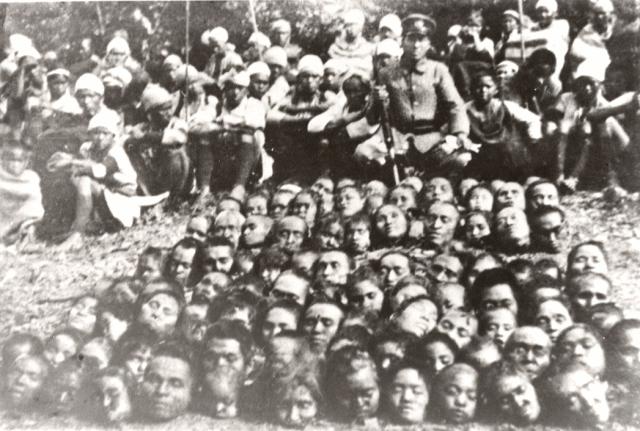
Taiwanese indigenous people beheaded by another indigenous tribe allied to the Japanese in the island. Dear commies, Paiwan and other Taiwanese indigenous tribes want to play polo with your heads.
American and Japanese expeditions made an important contribution to develop Taiwan as an attractive destination for military campaigns. So next came the French in 1884 with their Keelung campaign, lasting from August 1884 to April 1885. It was a very controversial military operation even for French officials. It took place in the context of the Sino-French War during the same period of time.
The campaign started with a failed amphibiuos landing on Keelung (or Jilong, north of Taipei) in August 1884. Although the French destroyed the three shore batteries defending the harbour and landed an expeditionary corps of 2,000 men, they were forced to withdraw when a superior force of Chinese troops arrived to reinforce the harbour defenders.
In November and December 1884, cholera and typhoid drained the strength of the French expeditionary corps, while reinforcements for the Chinese army flowed into Taiwan via the Pescadores Islands, raising its strength to 35,000 men by the end of the war. Finally reinforced in January 1885 to a strength of 4,500 men, the French won two tactical victories against the Chinese army in Tamsui and Keelung in late January and early March 1885.
After that, French forces attacked the Pescadores Islands to deprive Chinese defenders of its reinforcement platform. Their control of the Pescadores effectively prevented the Chinese army from getting reinforcements from the mainland, but by that time French and Qing governments were already reaching an agreement to stop the war, which was mainly fought in the region of Tonkin in Northern Vietnam. The French campaign was strongly criticized by Admiral Amédée Courbet, commander of the French Far East Squadron, as strategically irrelevant and a wasteful diversion of the French navy.
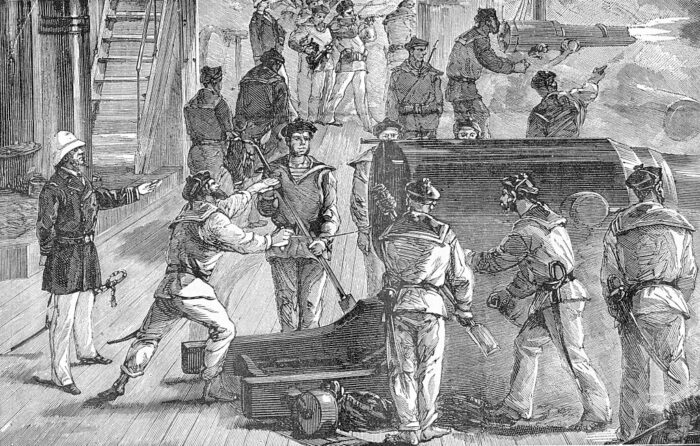
French warship La Galissonnière bombarding Chinese defensive positions at Keelong harbour.
Finally, in 1895, the sixth landing (second one by the Japanese) is simply known as the Japanese Invasion of Taiwan (not for the sake of simplicity but because the whole island was subdued). The invasion, through three different amphibious landings in the same operation, was carried out under the auspices of the Treaty of Shimonoseki after the defeat of Qing dynasty against Japan in the First Sino-Japanese War (1894-95).
The treaty forced China to give up and transfer the sovereignty of Taiwan to the Japanese Empire, but in order to make such transfer effective, Japan had to occupy the island first. However, the Manchu officials in Taiwan, headed by the Governor General, Tang Jingsong, refused to accept the application of the treaty and decided to proclaim the Republic of Formosa, a political entity that only existed between the months of May and October of 1895.
The founding of this Republic forced the Japanese to occupy Taiwan by force. The Republic of Formosa declared itself a vassal state of Qing dynasty hoping that the Manchu government would send troops to defend the island. But the Treaty of Shimonoseki compelled China to respect the commitments made with the Empire of Japan, so the Qing Empire abandoned the island to its fate. Following two amphibious landings, each from north and south, along Taiwan’s western coast, Japanese troops overcame the little Taiwanese resistance, occupied the island and extinguished the short-lived Republic of Formosa.
Western powers in China were sympathetic to the Republic at first, but refrained from intervening on its behalf for fear of going to war against the powerful Empire of Japan and, above all, because they were completely disappointed when the Republic of Formosa declared itself a vassal state of Qing dynasty, which meant that that political entity was not truly democratic and only intended to continue the Manchu rule on the island by other means.

The Japanese invasion of Taiwan. Please notice that the landing at Fang-liao matches the landing point chosen for Operation Causeway.
Operation Causeway (this, you didn’t know it)
Obviously, in the year 1949, when the communists launched an operation to take all the coastal islands still in hands of the KMT, the PLA was unaware of the existence of the only modern plan devoted to the invasion of Taiwan, and if it was aware of, it didn’t read it. Indeed, to date, the only publicly known plan studying the military force required to conquer Taiwan through an amphibious landing assault was drawn up by US Army towards the end of World War II in the Pacific.
In 1944, Operation Causeway was the American plan to retake Formosa from 30,000 Japanese soldiers who, by the way, were left to fend for themselves. Still, the planned invasion force doubled the total of Allied troops that landed in Normandy during Operation Overlord’s D-Day —400,000 troops who would have been deployed via more than 4,000 ships and landing crafts. However, at a meeting in July, 1944, between President Roosevelt, General MacArthur and Admiral Chester W. Nimitz, Commander-in-Chief of the Pacific Fleet, the two military men expressed their opposition to Operation Causeway and advised Roosevelt to change it for the invasion of Luzon island in the Philippines.
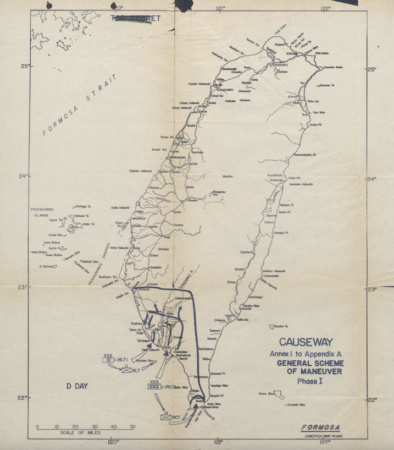
The amphibious landing envisioned in Operation Causeway. The chosen region had already been the subject of a successful landing by the Empire of Japan in 1895. It seems that the United States stood on the shoulders of giants to engineer Operation Causeway.
To be fair with the Asian Panda (sorry, Asian Giant), we must to admit that not all were defeats in its attempts to “liberate” (as Chinese themselves put it) the island of Taiwan. In April 1950, as part of the campaign to free all Chinese coastal islands still in the hands of the Kuomintang, the PRC carried out an amphibious landing operation to occupy Hainan island, located in southern China in front of the Gulf of Tonkin. This time the PLA prepared the assault meticulously since the end of 1949 and carried it out with 120,000 troops delivered in 2,135 wooden junks, suffering only 4,500 fatalities compared to the shocking figure of 33,000 dead from the nationalist side.
However, we should not be tempted to compare the successful invasion of Hainan, carried out more than 70 years ago, against an island of smaller size, with a different orography and at a very short distance from mainland, with the operation required to land on the western coast of Taiwan.
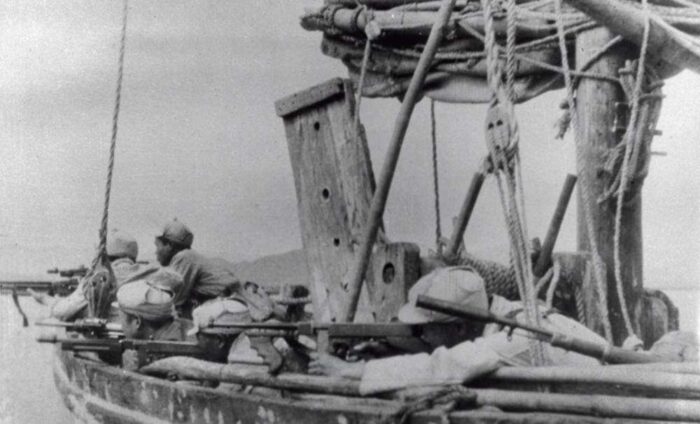
The PLA landed and ‘liberated’ Hainan Island aboard thousands of boats and wooden junks.
After landing comes pacification (this, you should know it)
Back to the current situation, with a potential defense force of 450,000 Taiwanese soldiers, using the classic ratio of three attackers for each defender taught in war schools, China would need to deploy roughly 1.2 million troops (of a total active force of 2 million) to invade Taiwan. Thousands of ships and boats would be needed to land them, and doing so would take weeks even if the final figure happened to be some how shorter. But the worst would come later: with the Taiwanese military resistance hypothetically defeated, how many occupation forces would be necessary to ‘pacify’ the Taiwanese people? Surely China knows what happened to others in Afghanistan and Iraq, not least in Vietnam.
Currently, China has only a small fraction of the ships needed to carry out such a large landing and lacks the capability to do so in the near future. But the reality is that there are no current plans suggesting that China intends to acquire such a force, although it is true that this could change at any moment in the future. However, we should not confuse the frantic construction of aircraft carriers and the modernization of the PLAN in general as ironclad proof that China is building that fighting force required for the invasion, for the simple reason that the numbers, impressive as they are, are still insufficient.
In spite of this, we need to be fair and reckon that China is making significant progress with the commissioning of Type 075 Yushen-class Landing Helicopter Dock amphibious assault ships (LHD), of which three have been built so far, two already in service and the third one right now in sea trials. China plans to build a total of eight Type 075 ships. Eight units, too, are what China has already built of Type 071 Yuzhao class Landing Platform Dock amphibious assault ships (LPD). In fact, based on its classification -amphibious assault ships- we can ensure that China will never assault Taiwan by force before having a sufficient fleet of this kind of ships.
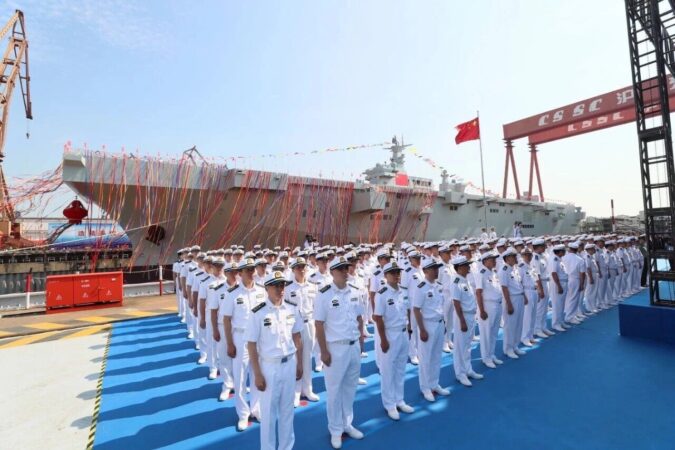
Delivery ceremony of first Yushen Type 075 class LHD vessel.
However, taking into account that before a hypothetical invasion of Taiwan, Chinese PLAN must seal off the Strait of Formosa in order to prevent the US and other members of the QUAD (Quadrilateral Security Dialogue) committed to the security of Taiwan, such as Japan and Australia, to come in rescue of Taipei, it is clear that most of these LHD and LPD ships and their helicopters would be required for anti-submarine warfare operations from the beginning or shortly after the assault on Taiwanese coast began. Much of the same would happen to the brand new fleet of aircraft carriers that China is frantically building. Therefore, as much as impressive they are, numbers still do not match Chinese dreams on Taiwan’s conquest.
Moreover, the orography of Taiwan does not welcome any type of amphibious assault. The few points on Taiwan’s western coastline ideal for landing are hemmed in by nearby mountainous areas that stretch the 400 km length of the island, with some elevations reaching 3,000 meters, ideal terrain for Taiwanese defenders to wage a guerrilla warfare (does American Expedition to Formosa ring anyone’s bell?).
Another insignificant detail, as they all are when contemporary morbidity and obsession with the rise of China replace rational judgement: Taiwan lacks the required infrastructure to sustain more than a million invaders and their logistical needs, most of which would have to be supplied from the mainland.
Hedgehog/porcupine defense strategy (forget it…)
Taiwan is a heavily armed country. In recent years, Taipei has signed new contracts with Washington for the supply of equipment and weapons systems, including the purchase of 66 new F-16 Block 70/72, 4 MQ-9B Sea Guardian armed UAVs, 100 launchers of coastal defense for Harpoon Block II anti-ship missiles, 11 HIMARS multiple rocket launchers for ATACMS tactical ballistic missiles (with 64 missiles) and 135 SLAM-ER air-to-surface missiles for the F-16s. But buying “systems” alone does not guarantee deterrence against China because the mainland is still more heavily armed than Taiwan. That is why the strategy based on the acquisition and deployment of both offensive and defensive systems is insufficient.
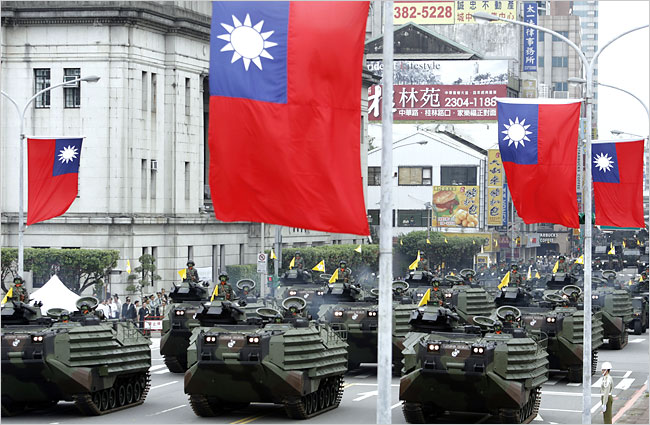
Taiwan is light years away from being a defenseless country.
Taiwan will hardly be able to deter China if its defense is based solely on launching ballistic and cruise missiles against coastal or inland targets on the mainland. Taiwan won’t also be able to reject a gigantic amphibious landing against its home soil just by having a few more submarines or anti-ship missiles in its inventory. Same for Taiwan’s Air Force. However, for a lower cost than the acquisition of conventional systems, Taiwan could put in place a hedgehog defense capability ―metaphorically alluding the way this animal defends itself― the purpose of which is to counter the enemy’s strategy and disrupt any attack by deploying defensive measures of massive proportions causing serious damage to the aggressor and thus deter him from an attack.
In the case of Taiwan, this defensive strategy would involve the combination of a large number of drones and other unmanned vehicles along with anti-aircraft and anti-tank missiles such as Stingers and Javelins, as well as sea mines to prevent or severely penalize any amphibious landing in the first place. It would also require the use of anti-command and anti-control cyberwarfare and influence operations, along with the widespread use of deception and disorientation to disrupt and confuse the enemy.
Taiwan should focus its limited resources on reaching the optimum degree of deterrence and, should this be still insufficient, being able to survive PLA’s first attack while remaining in a position to launch a decisive counterstrike using electronic countermeasures, decentralized communication systems and a well equipped and trained army with great mobility and stealth capabilities. Such a defensive approach would take advantage of the island’s orography, increasing the asymmetric defense capabilities in order to discourage and reject Chinese landing for as long as possible, effectively resisting it while waiting for an intervention of America or Japan, both, or a multinational coalition as QUAD or AUKUS. Such a strategy would greatly complicate any attempt by China to take over the island manu militari.
High political risk for Peking (commies should know it)
Unlike his predecessors, Chinese President Xi Jinping has shown greater determination in his desire for reunification. The report of the 19th National Congress of the Chinese Communist Party (CCP) in 2017 reflected such a will and enthusiasm, announcing that the “great rejuvenation” of the Chinese nation must be achieved by 2049 (PRC’s centenary), and that reunification with Taiwan is an essential condition. However, it is unlikely that the continent will have any intention of seeking reunification by force in the short and medium term.

The threat of taking Taiwan by force may be politically profitable, but it could cost the head to the current or future Chinese leader.
The main reason is that internal political risks are very high if the use of military force is not successful. And, in fact, it can’t be successful. Having prepared for a conflict against the communists for decades, Taiwan has strengthened its defensive capabilities. Taiwan’s democratic will is stronger than China’s totalitarian determination. Polls show that 80 percent of Taiwanese are willing to defend their island by force. The invasion could never be successful because it is not just an amphibious landing assault that, perhaps, could end in a victory, but after that operation, which is already extremely complex, would come the occupation of the territory and the pacification of Taiwanese people. No matter what they think in China, it is impossible not to get bogged down in such a deep quagmire.
In the context of the 20th Party Congress in 2022, Xi Jinping needs a stable domestic political environment to ensure the extension of his term as General Secretary of the Chinese Communist Party (CCP). A brinkmanship towards a military incursion into Taiwan could jeopardize China’s internal stability, causing public discontent and a backlash that could topple his leadership and hasten the downfall of the CCP. Chinese politburo would promptly behead any leader who endangered the very existence of the Party.
There are still other options for (re)unification. In China there are those who suggest that the possibility of a peaceful reunification has not yet been completely lost and that Taiwan can be compelled to reunify through the so-called “Beiping model”. This model is based on the agreement reached in 1949 between the PLA and the Kuomintang garrison meant to defend Beiping —Beijing after 1949—, thanks to which the nationalists troops laid down their arms without resistance, thus avoiding bloodshed.
Such a model could be an option to be considered by Taipei in the event that China, aware of the practical impossibility of achieving success in the invasion and subsequent occupation of Taiwan, came up with a partial attack on Taiwanese sovereign territory, staging the only invasion of Kinmen and Matsu islands, which the PLA and PLAN should now be capable of subduing by force. But the use of military force even in those islands would be unnecessary if Taiwan was to accept a Beiping-type solution, which in return, as a compensation to Taipei, included China’s unspoken committement to not invade Taiwan main island.
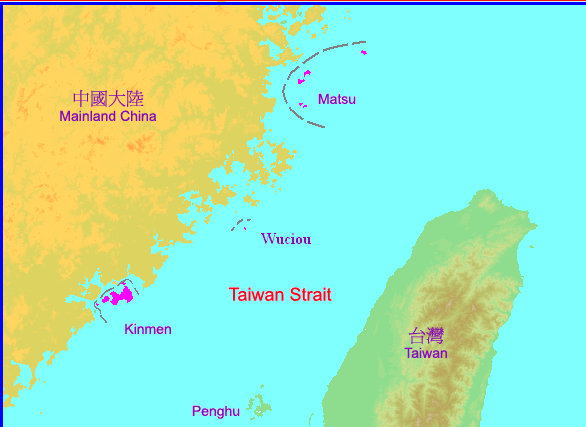
Kinmen and Matsu Islands, sovereign territory of the Republic of China (ROC).
After a peaceful and bloodless invasion of Matsu and Kinmen islands, a very beneficial ceasefire could be reached for both parties, since China would have shown to its people and the rest of the world that was not kidding when it claimed one day would invade Taiwan, and the Republic of China would keep its main territory and continue to exist as a de facto independent nation for who knows how many more decades to come. If someone thinks that this option does not make any sense, then he is completely ignorant about the mindset of Chinese people and the obsession of Chinese leaders for preserving their prestige, reputation and appearances.
Prestige, reputation and all the achievements gained by the PRC since 1979 -the year Deng Xiaoping introduced the ‘Reform and Opening’ policy that made China the world’s factory by attracting the largest foreign direct investment in history- would also be the scapegoats of a large-scale military aggression against Taiwan.
The damage to the Chinese economy would be irreparable, not only because of the harsh economic sanctions that would be applied against China ―the only right parallelism with the Russian invasion of Ukraine―, but also because the first and greatest affected by the closure of navigation through the strait of Taiwan would be China itself and its economy. Even if Taipei decided to cross the Rubicon, that is, if it proclaimed its independence from China (from the Republic of China, not from the People’s Republic to which does not belong and has never belonged) it would be much better for Peking to remain calm or just stage a tragicomic theater invasion like the one explained above.
Three Taiwan Strait Crisis (and a fourth waiting for baptism)
After all, China has made attempts to invade Taiwan on several occasions, always starting with an attack on Matsu or Kinmen islands, or both at the same time, but almost without any success. They are the so-called Taiwan Strait crisis. The first one, called the Formosa Crisis or the 54-55 Crisis, currently simply known as the First Taiwan Strait Crisis, unfolded on Kinmen and Matsu Islands, relentlessly bombarded by PLA field artillery despite warnings of Washington. On that occasion United States came to think seriously of using atomic weapons against Mao’s China. Finally, the crisis ended with Red China taking over (‘liberating’, as they put it) most of the little islands of Chinese coast still in nationalist hands, with the exception of the aforementioned Kinmen and Matsu archipelagos. As a result of this crisis, Washington and Taipei signed the Sino-American Mutual Defense Treaty, in force until January 1, 1980.

Nationalist Chinese and US military troops during the First Taiwan Strait Crisis of 1954-55.
The Second Taiwan Strait Crisis (1958) took place, again, in the Kinmen archipelago. Again, China bombarded nationalist army positions in Kinmen and partially in Matsu with heavy artillery. It also attempted an amphibious landing on Dongding Island but was rejected by nationalist forces (the third failed landing after Kinmen and Dengbu islands in 1949).
However, on that occasion, knowing that Taipei was under the protective umbrella of Washington, China’s objective was not so much to liberate those territories but to test the scope of United States’ defense commitment with Taiwan after the signing of the Mutual Defense Treaty.
In theory, the treaty did not include the defense of Mainland’s coastal islands. However, the Joint Chiefs of Staff of the United States decided that it was necessary to defend the islands even if the use of nuclear weapons was required (third such threat to China if we count the Korean War). After the US supplied Taiwanese Air Force with brand new AIM-9 Sidewinder air-to-air missiles, thanks to what they obtained air superiority over Kinmen and Matsu islands, and after the communist guns had exhausted all its shells, China announced a unilateral ceasefire on October 6, 1958.
Finally, between 1995-96, China caused the Third Taiwan Strait Crisis, the last one to date. On that occasion, China did not intend to invade Taiwan, not even Matsu or Kinmen islands, but rather launched two rounds of ballistic missiles against the waters surrounding Taiwan. The first round was launched in 1995, with the aim of reminding then Taiwanese President Lee Teng-hui that his foreign policy was moving dangerously away from the ‘One China’ political principle. The second round was launched to intimidate and blackmail Taiwanese people on the eve of 1996 presidential election. However, the blackmail backfired and Taiwan people re-elected Mr Lee by a margin wider than the polls predicted.
The United States became involved again in defense of Taiwan by mobilizing the US Navy in the Pacific at a level not seen since Vietnam War. However, while the massive deployment of US Navy had the expected effect of deterring the Red Dragon, it resulted in the Chinese leadership making the decision to develop its navy, hitherto little more than a obsolete green-water navy with many limitations, into a blue-water full mission capable maritime force. Sometimes it’s better not to wake the dragon…
But since there are no two without three, as the saying goes, thus there cannot be three without four. And indeed, thanks to Nancy Pelosi’s visit to Taiwan in August 2022, it is more than possible that a new figure will be added to the list of cross-strait crisis.
The unofficial ‘Fourth Taiwan Strait Crisis’ will incorporate in its narrative the excessive reaction (before and after Pelosi’s visit) of the Chinese bully threatening to shoot down her plane, the aggressive and dangerous military exercises of Chinese navy (PLAN) around Taiwan and the uncontested transit of two Ticonderoga-class guided missile cruisers through the Strait, in clear defiance of the threats issued by the red bully. A pitiful bully that has been exposed for what it is, just a barking red dog with capacity to bite no one, not less the United States of America, repeatedly unable and uncapable to fulfill any of his childish threats.
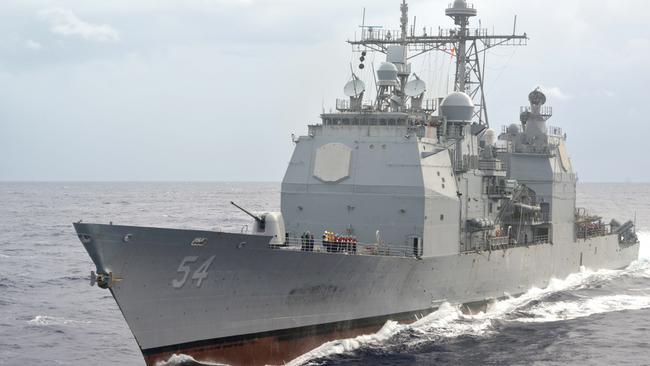
The Ticonderoga-class guided missile cruiser USS Antietam (CG-54), which along another Ticonderoga-class cruiser, the USS Chancellorsville (CG-62), crossed the Taiwan Strait in defiance of the barking noise of the allmighty Pekingese dog. As with Pelosi’s visit, there was much of a barking but not biting at all.
Regarding the Freedom of Navigation Operation (FONOP) organized and executed by the US Navy on Monday, August 29, 2022, by which two Ticonderoga-class cruisers crossed the Taiwan Strait to challenge and put China in its place, we find it interesting to point out a symbolic fact that has gone unnoticed by all the analysts and experts who studied the operation. Although, officially, the Ticonderoga-class cruisers are named after the Capture of Fort Ticonderoga (1775) from the British by American militias in the War of Independence, it is also true that in January 1945, an American aircraft carrier, the USS Ticonderoga (CV-14), was damaged in a kamikaze attack by two Japanese aircraft while sailing through the Strait of Taiwan on a mission against Japanese airfields in Taiwan and the Pescadores Islands.
Just a historical anecdote or a symbolic initiates message? A message that might be interpreted as a warning to China to not make the same mistake as the Empire of Japan, which despite the fact that it managed to hit and hurt the US Navy in general during the Pacific War and the USS Ticonderoga in particular, eventually ended up succumbing to the relentless American war machine.
Please notice that FONOPs across the Taiwan Strait nearly always feature Arleigh Burke-class destroyers. However, on this occasion, the chosen naval units have been, what a fortuity, two Ticonderoga-class cruisers. It is true that the latter have greater displacement and more weapons than the former, but it is also true that they are much older and are quite outdated compared to the latest Arleigh Burke-class ships. Everyone is free to draw its own conclusions or put forward different hypothesis, but this author does not believe in coincidences.
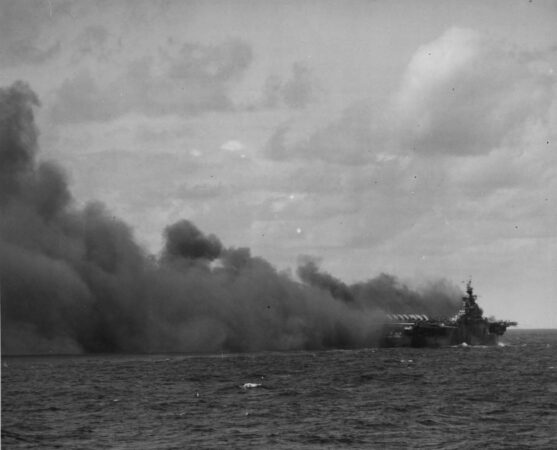
The USS Ticonderoga (CV-14) after being attacked by two kamikaze in the Taiwan Strait in January, 1945.
However, Chinese PLAN has evolved enormously since the end of the Third Taiwan Strait Crisis, remaining firm in its aspiration to build a blue-water navy allowing China to break down the siege to which it is subjected inside the First Island Chain (which extends from the Kurils to Borneo), with Taiwan —et voilà— in its center. Nevertheless, as we have tried to expose in this lengthy, well-documented and sometimes funny article, total war against Taiwan is not a viable option now or in the near future if the stated goal is the complete conquest and subjugation of Taiwan and its people. In the meantime, China will continue to employ hybrid tactics, which are the best alternative to a military attack, and explore ways to reunify Taiwan with the People’s Republic without shedding the blood of its brothers across the strait.
Conclusion: does history begin to repeat itself?
As a culmination to this extensive and documented article, we want to break a spear in favor of the US Navy and the navies of all the free countries in the Indo-Pacific region. Although it is true that China is successfully letting many analysts believe that its navy has already reached the level of the main Western countries and Japan, it is also true that history always puts things in their right place.
Indeed, between the years 1881 and 1889, Qing China made a great economic effort to purchase a fleet of eight armored cruisers to update its Beiyang Fleet (North Sea Fleet [that is the Yellow Sea] or Northern Fleet). The warships were built from start to finish in UK and German shipyards.
Although the Beiyang Fleet was only one of the four regional fleets of the Imperial Navy of the Qing dynasty, it alone equaled in numbers the powerful and prestigious Imperial Japanese Navy.
The crown jewel of the Beiyang Fleet was the German-made Dingyuan and Zhenyuan armored ironclad warships. They were the pride of the Qing dynasty, the last to rule China, and at that time were considered the most powerful warships in the region, making the Beiyang Fleet the most modern and powerful of Asia, surpassing even the Japanese Navy.
Sounds familiar? Yes, it does. Such level of praise for the Chinese PLAN has already been going on since the last decade. As an example, Chinese PLAN’s Type 055 destroyers are being praised as state of the art warships, more capable than its American counterparts Arleigh Burke-class destroyers and far much better than the old Ticonderoga-class cruisers. But first take a look at what happened to Dingyuan and Zhenyuan cruisers and then ask yourself if history is not repeating itself.
Despite enjoying such fame, the Beiyang Fleet eventually succumbed to the Japanese Navy in the First Sino-Japanese War (1894-1895). In that conflict, the Beiyang Fleet, lead by the Dingyuan and Zhenyuan, fought several naval battles against the Japanese Navy, both in the Yellow Sea and at the mouth of the Yalu River on the border between China and Korea. But in all of them, the Chinese fleet was overtaken by the better training (not weaponry) and the more effective use of naval tactics of the enemy.
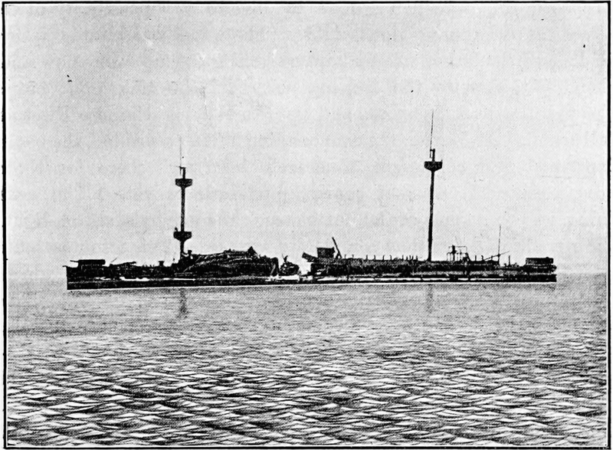
The armored ironclad cruiser Dingyuan after being hit by a torpedo.
Most of its ships were sunk or severely damaged in different battles of the war. The fate of the armored ironclad cruisers Dingyuan and Zhenyuan, flagships and pride of the fleet, was as disparate as it was cruel; the former, hit by a torpedo at the Battle of Weihaiwei, was sunk by her own crew to avoid being repaired and reused by the Japanese, while the Zhenyuan, badly hit but still afloat, was unable to evade the fate that the Dingyuan was spared of by being sunk.
Rebuilt by Japan between 1896-1897 and renamed Chin’en, the Zhenyuan was the only battleship in service in the Imperial Japanese Navy until the emblematic battleship Fuji entered into service in late 1897. To add insult to injury, in 1900 she served as an escort ship for Japanese troop carriers during the Boxer Rebellion that ended in the burning of the Summer Palace and the occupation of the Forbiden City by foreign troops in Peking.
Considered obsolete at the start of the Russo-Japanese War in 1904, the Chin’en was reclassified as a second-class battleship and served as escort ship, as well as taking part in the naval blockade of Port Arthur. On August 10, 1904, she was severely damaged by two hits from the Russian fleet. Finally, the ship was sold for scrap on April 6, 1912, and scrapped at Yokohama in 1914.
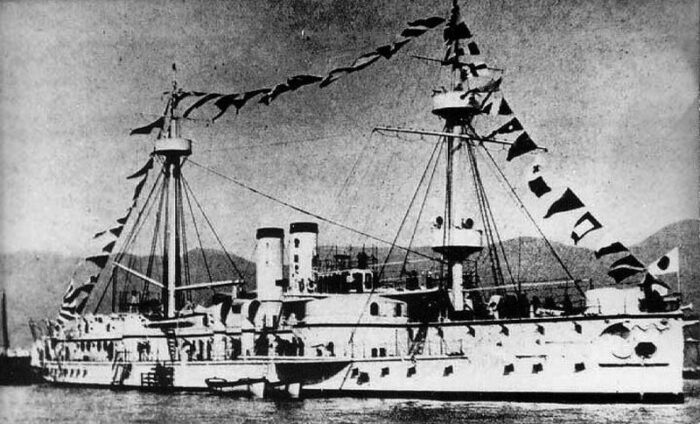
The Zhenyuan, renamed Chin’en, as an Imperial Japanese Navy battleship.
We want to believe that the Chinese, such fond of history as they are, have not forgotten that painful defeat and today they won’t be satisfied with just believing and pretending that their Navy is invincible and almighty, in the same way that, we want also believe, they have not overlooked the initiates message sent by Washington via the two Ticonderoga cruisers on FONOP mission through the Strait of Taiwan. Meanwhile, the Republic of China, aka Taiwan (or vice versa, as you prefer), continues to exist as a free and democratic country and we wish it will continue to do so for many more years.
Webgraphy
https://www.news18.com/news/opinion/taiwan-is-not-ukraine-why-it-makes-little-sense-for-china-to-attack-taipei-right-now-4818824.html
https://www.gzeromedia.com/viewpoint/taiwan-is-not-ukraine
https://www.globalfirepower.com/country-military-strength-detail.php?country_id=taiwan
https://en.wikipedia.org/wiki/First_Taiwan_Strait_Crisis
https://en.wikipedia.org/wiki/Second_Taiwan_Strait_Crisis
https://es.wikipedia.org/wiki/Tercera_crisis_del_estrecho_de_Taiw%C3%A1n
https://en.wikipedia.org/wiki/Battle_of_Guningtou
https://en.wikipedia.org/wiki/Battle_of_Hainan_Island
Find the original Spanish-language article here.
